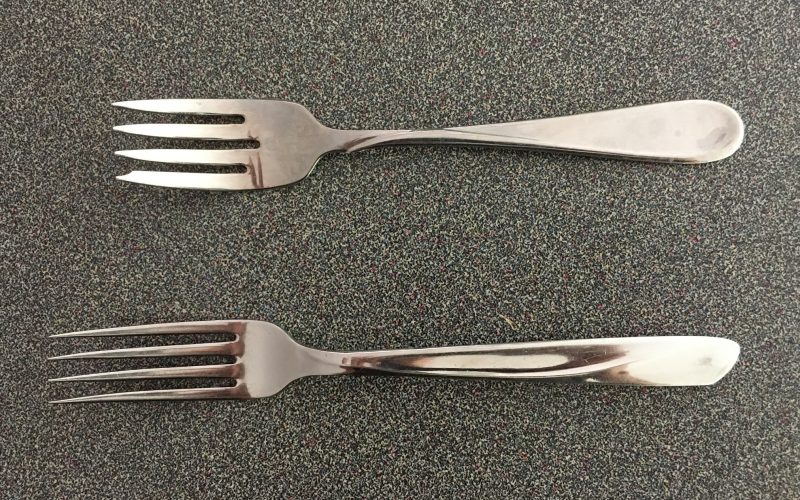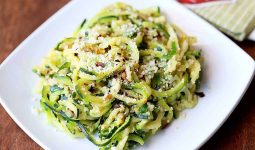We use forks daily without giving them much thought, but did you know there are different types of forks?
This post will explore the various types of forks and how they are used daily.
We’ll look closer at the different types of forks, from salad to dessert forks, to better understand how each type of fork is used.
Whether you’re looking to impress your dinner guests or just brushing up on your silverware knowledge, this post will provide the necessary information to serve up the knowledge about different types of forks.
1. Icecream Fork
Ice cream is a beloved treat that can be enjoyed year-round. However, enjoying it can sometimes be a bit messy.
This is where the ice cream fork comes in! Unlike traditional forks, ice cream forks have a smaller, curved design to scoop up ice cream better.
Different ice cream forks may also have various patterns or decorations on their handles.
If you want to add a touch of elegance to your ice cream experience, consider using a silver or crystal ice cream fork.
These forks are perfect for formal occasions and add a luxurious touch to your dessert presentation.
Alternatively, if you’re a fan of the quirky and fun, there are ice cream forks shaped like animals or other unique designs.
These are great for kids’ parties or for wanting to inject playfulness into their ice cream indulgence.
Whether you prefer traditional or unique designs, there is an ice cream fork for everyone.
So the next time you’re enjoying a scoop (or three) of your favorite ice cream flavor, why not try it with a different type of fork and elevate your dessert experience?
2. Deli Fork
If you love indulging in delicious deli meats and cheeses, your cutlery collection must have a deli fork.
These forks typically have shorter and broader tines, allowing you to pick up small slices of meat and cheese easily.
The tines of deli forks are often sharper than traditional forks, allowing you to spear through tougher meats and cheeses easily.
These forks also usually have wider handles, making them easy to grip and maneuver.
Whether putting together a charcuterie board or serving up some cold cuts for a party, a deli fork is a convenient and essential tool for any foodie.
Plus, with their sleek and stylish designs, they’re sure to impress your guests and elevate your culinary presentation.
3. Salad Forks
When enjoying a delicious salad, you’ll want the right utensil. Enter the salad fork, one of the Different Types of Forks you may have encountered before.
These forks are smaller than standard table forks and typically have a narrower and longer design, which makes them perfect for spearing leafy greens and other delicate vegetables.
There are different salad forks, each with its unique design and function.
Some have wider tines that make it easier to scoop up larger salad pieces, while others may have more delicate and thinner tines better suited for daintier salads.
If you’re a fan of entertaining, you may want to invest in a set of salad forks that match your other tableware.
This can help create a cohesive and elegant dining experience that your guests will appreciate.
No matter your personal preferences, there’s no denying the importance of having the right fork for the job.
Regarding salads, reach for your trusty salad fork to ensure a smooth and enjoyable eating experience.
4. Dessert Forks
Dessert forks, as the name suggests, are specifically designed for eating desserts.
They are smaller than regular dinner forks and usually have three tines instead of four.
The purpose of the extra time is to help the fork cut through dense and sticky desserts like cheesecake, fudge, or pudding.
Dessert forks are typically included in a formal place setting along with the salad fork and the dinner fork.
They are usually placed above the plate or bowl, parallel to the dinner fork. Dessert forks are often paired with a dessert spoon for soft desserts like custard or mousse.
Dessert forks come in various materials, including stainless steel, silver, and gold.
Some designs also feature ornate handles or embellishments to add a touch of elegance to the dessert course.
When using a dessert fork, it’s important to remember proper etiquette.
Dessert forks should be held like a regular dinner, with the tines facing downwards.
They should be used to cut through and pick up small bites of dessert rather than taking large bites.
Dessert forks are a specialized tool that adds a touch of sophistication to any dessert course.
Whether indulging in a decadent chocolate cake or a light fruit tart, a dessert fork is perfect for enjoying sweet flavors.
5. Fish Forks
Regarding seafood, it can be tricky to know which utensil to use. That’s where the fish fork comes in.
Fish forks typically have longer, narrower tines than regular table forks, allowing them to maneuver around bones and delicate fish meat easily.
In addition to their specialized design, fish forks often have an extra feature: a small notch or spike at the end of the handle, which can be used for poking and removing bones.
Some fish forks even come paired with a matching fish knife with a serrated edge to help cut through tougher fish skin.
While fish forks may not be as commonly used as some other types of forks, they are certainly a valuable addition to any seafood lover’s utensil collection.
Whether enjoying a platter of oysters on the half-shell or a perfectly cooked piece of salmon, the fish fork can help you navigate your way to seafood perfection.
6. Serving Forks
Using a serving fork is essential when serving large dishes like roasts, turkeys, and hams.
These forks have a long, sturdy handle and two slightly curved tines to easily pierce and lift large pieces of meat or poultry.
For casual occasions, serving forks come in various materials, including stainless steel, silver, and even plastic.
Depending on your preferences, they can be used alone or as a set with a matching serving spoon.
Holding the handle firmly and gently piercing the meat or poultry is essential when using a serving fork.
Slowly lift the piece and transfer it to the serving dish. Be careful not to drop or lose precious juices as you transfer the meat.
Some serving forks have a carving knife attached to the handle, making it even easier to carve and serve meat at the table.
These sets often come in a stylish box, making them an excellent gift for anyone who loves to host dinner parties or holiday gatherings.
Serving forks are an essential tool for any home cook or entertainer. They make serving large dishes a breeze and add a touch of elegance to any table setting.
7. Cocktail Forks
When it comes to cocktail parties, having the proper utensils to serve your guests is essential.
This is where cocktail forks come in! These little forks are the perfect size for appetizers and hors d’oeuvres.
There are Different Types of Forks for cocktails, but the most common ones have a narrow and pointed tine that can easily spear small bites of food.
They are shorter than regular forks, usually 5 to 6 inches long. Cocktail forks can be made of various materials, such as metal, plastic, or bamboo, depending on the occasion and your preferences.
Cocktail forks are helpful when serving foods like shrimp, oysters, and even olives in your martini glasses.
They are also perfect for appetizers such as cheese cubes or stuffed mushrooms.
A cocktail fork can help prevent your guests from double-dipping or using their fingers to pick up the food, keeping everything hygienic.
When setting up a cocktail party, you’ll want a good supply of cocktail forks.
Depending on the size of your party, having at least three forks per person is recommended.
You can use them to serve appetizers and small bites during cocktail hour or dinner with friends. Cocktail forks are a must-have for any party host.
They come in various shapes and sizes and can be used for different purposes.
Whether you’re hosting a fancy dinner party or a casual get-together with friends, cocktail forks will surely add elegance to your event.
8. Table Fork
One of the most commonly used forks, the table fork, is designed for general eating purposes.
This versatile utensil features four straight tines and a handle that is longer than those of other forks. It’s ideal for main courses, side dishes, and desserts.
The table fork is available in various sizes, from the standard seven-inch size to the larger nine-inch size, depending on the occasion and the menu.
When using a table fork, it’s essential to hold it securely in your hand and place it at the side of your plate when you’re not using it.
Whether you enjoy a juicy steak, a bowl of soup, or a slice of cake, the table fork is trusty and essential for dining etiquette.
While it may seem like a simple utensil, it’s essential to use the proper fork for the type of food you’re eating.
Next time you sit down to a meal, take note of the forks on the table and select the correct one for each course.
Using the right fork will enhance your dining experience and showcase your knowledge of proper table etiquette.
9. Spork
The spork is an innovative utensil that combines the functions of a spoon and a fork.
As its name suggests, it resembles a hybrid of a spoon and a fork, with a scooping end that transitions into two or three prongs.
This versatile utensil is perfect for eating a variety of dishes, especially those that require both spooning and forking actions.
Like other types of forks, there are different variations of the spork. Some sporks have three prongs, while others are smaller and only have two.
Additionally, some sporks may have a serrated edge that can be used to cut soft foods.
Sporks are commonly found in fast-food restaurants and cafeterias, as they are an efficient way to serve food without needing separate utensils for spooning and forking.
However, they are also great for outdoor activities like camping and picnicking, where packing multiple utensils can be inconvenient.
The spork is a valuable addition to any utensil set and a testament to the versatility and innovation achieved with Different Types of Forks.
10. Granny Fork
A granny fork, a pickle fork, or an olive fork is a small fork with two or three short prongs.
It is commonly used to pick up small, slippery foods like pickles, olives, and cocktail onions. The design of the granny fork is perfect for this purpose.
The short prongs are sharp enough to pick up the food, while the curved handle lets the user grip the fork securely.
Some granny forks have decorative designs or patterns on the handle, adding elegance to the table setting.
While the granny fork may seem like a minor utensil, it is still essential to have it on hand, primarily if you are serving appetizers or finger foods at a party or gathering.
Plus, it’s a great way to impress your guests with attention to detail and culinary knowledge. The granny fork is a valuable utensil for picking up small, slippery foods.
It’s also a great way to add elegance to your table setting and impress your guests.
So next time you’re serving appetizers or finger foods, don’t forget to include the granny fork in your arsenal of utensils.
11. Toasting Fork
One fork you may not have heard of before is the toasting fork. This fork is designed for toasting bread over an open flame, such as a campfire or fireplace.
Different toasting forks may vary in length and prongs, but they all serve the same purpose.
Using a toasting fork is a great way to make toast when you can’t access a toaster.
Place a piece of bread on the end of the fork and hold it over the flame until it’s toasted to your liking.
While it may not be as convenient as a toaster, it’s a fun and unique way to enjoy your toast.
Overall, many different types of forks are available for various purposes.
Each type serves a specific function, from the spork to the toasting fork, and can add value to your dining experience.
So next time you sit down for a meal, take a moment to appreciate the different types of forks at your disposal and choose the one that’s right for you.
Conclusion
The world of cutlery is vast and varied, and different types of forks are just one aspect.
Whether you’re serving up a fancy fish dinner or indulging in some ice cream, there’s a fork out there for every occasion.
The possibilities are endless, from cocktail forks to table forks, sporks to granny forks.
By understanding the different types of forks available, we can make more informed choices regarding dining and entertainment.
So next time you’re setting the table or ordering a meal, consider the role that different types of forks might play in the experience.
Bon appétit!








